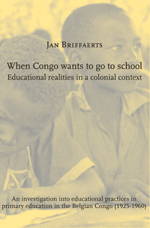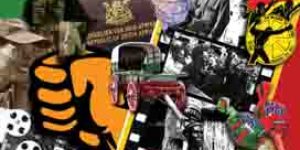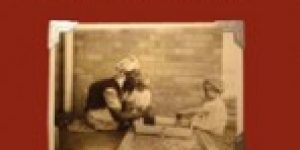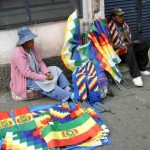When Congo Wants To Go To School – Part II – Realities
No Comments yet In the following chapters I will try to reconstruct the educational reality in the schools of the MSC based primarily on the written sources available. More specifically, this relates to the reconstruction of classroom life and the educational relationship between missionaries and pupils. The closer one gets to the so-called ‘micro level’, the more apparent it becomes that it is almost impossible to make a true reconstruction in the sense of a true representation, “wie es eigentlich gewesen ist”, of the educational relationship between missionaries and Congolese. Naturally, the source material available is important here and defines the boundaries within which the research can be carried out.
In the following chapters I will try to reconstruct the educational reality in the schools of the MSC based primarily on the written sources available. More specifically, this relates to the reconstruction of classroom life and the educational relationship between missionaries and pupils. The closer one gets to the so-called ‘micro level’, the more apparent it becomes that it is almost impossible to make a true reconstruction in the sense of a true representation, “wie es eigentlich gewesen ist”, of the educational relationship between missionaries and Congolese. Naturally, the source material available is important here and defines the boundaries within which the research can be carried out.
A second important matter is that the teaching was not given by the missionaries in the first place, but by the Congolese. This is not unique to the Missionaries of the Sacred Heart, it is more generally true for the entire colony. From the beginning an appeal was made to native assistance, to carry out the huge quantity of work caused by the evangelisation project. A decision was already made in 1907 by the bishops in the Congo to establish a central teacher-training course for each church province. The reason for this was of course the unbalance between the personnel available and the population to be reached. The fact that evangelisation was much more important to the missionaries than the educational activity meant that it was “sufficient” initially to train the Congolese as catechists and that it was not necessary in the strict sense to train teachers. This was also emphasised in those first plans: the candidates for training had to be young (maximum 12 years old) and it was explicitly stated that the intention was not to train educationalists but catechists as assistants to the missionaries.[i] According to Antoine Dibalu there were 11 central teacher-training colleges in 1922, of which those closest to the Equator province were situated in Nouvel Anvers (North of Coquilhatstad) and in Tumba (by Lake Tumba, South of Coquilhatstad).[ii] However, it is likely that not everybody who became teaching assistant had actually attended a teacher training college. That was certainly true in the mission region of the MSC.[iii] One example of this can be found in the Annals from 1929: “On Tuesday there is a school inspection. Notwithstanding all kinds of unfavourable circumstances satisfactory results have been achieved. The head teaching assistant, Georges Lobombe, although he has not had any professional training, was given an honorary mention in the inspector’s report.”[iv][v]
From a statistical summary from 1934 it is apparent that a little over 120 “white” religious workers were working in the vicariate Coquilhatstad, together with 90 teachers and 357 catechists. It was also stated that there were another eighty pupils or so at the teacher training college at that time. Consequently, an attempt was made to have trained teachers but that was clearly not always the case. Moreover, the same was true for the missionaries themselves. They had, barring a few exceptions, no educational training. The missionaries’ role was often limited to supervising the teaching assistants and to giving religious education. One of the many testimonies in this regard was given in the Annals by Sister Godfrieda, a Sister of the Sacred Heart, who worked in the newly established mission post in Bolima from 1934: “Here you will find Sr. M. Godfrieda, who tries to keep order with two black helpers among the three hundred and fifty rascals and to drum the first concepts of discipline, prayer and the catechism into them and to teach them some letters and arithmetic.”[vi] Relatively speaking, more people with educational training could be found among the sisters than at the MSC. The MSC were not a teaching order by nature. Consequently, it should not be surprising that when a large school had to be established in a central place, as in Coquilhatville, the Brothers of the Christian Schools were appealed to, being traditionally considered an educational congregation.
The majority of teachers in education were Congolese. Naturally, when considering the educational reality and the classroom life those teaching assistantsare important witnesses. However, in the same way as for the pupils, it is much more difficult to trace their voice than the coloniser’s. A limited number of them did manage to become “évolué” and a number of testimonies about education may, for example, be found in this way in “La Voix du Congolais”. But there we are also dealing in essence with superficial and ideologically distorted messages. Moreover, and that is also true to a great extent for the other parties involved, these sources rather represent experiences of events or behaviours rather than the reality itself. However, as Dams, Depaepe and Simon have remarked, that does not necessarily have to be considered a fatal inadequacy for the historian.[vii] However, insofar as possible the “gap in the memory” is completed by a number of oral testimonies from people involved in education. They will primarily be considered separately in the last part. Oral sources have their own specific interpretative issues. It is not possible to consider them individually without further context. Nevertheless, I would also like to consider them on their own because the aspect of “remembering” is interesting and intriguing enough to consider them separately.[viii] Questions about memories over a longer term are an extension of those about the effects of education. That part of the research may then be properly considered as more “anthropological” in nature (cf. the introduction).
However, the second part relates to the basic material that should make it possible for us to form an idea of the main aspects of education in this region of the Belgian colony (and by extension, and in general, these findings are also true for the rest of the colony). This account is organized around a number of themes, which I used to relate to the source material.[ix] The headings used may of course be debated (what is an “educational climate”?) but the primary intention was to introduce a kind of general, first classification of the material available. Grosso modo these themes can be divided as follows (see diagram). The intention is to consider the field of work in four chapters, each from a different themed perspective. It is almost impossible to make an absolute boundary, hence the warning that this is a “rough” division. The intention is certainly not to divide reality into numerous smaller realities. For that reason it is also necessary for the themes to overlap somewhat.
1. Educational climate:
What was the educational aim and environment?
What was the dominant view of Congolese children?
2. Educational comfort:
Material construction and organisation of schools
Timetabling
3. Content of lessons and implementation of the curriculum:
What was taught?
How were subjects taught?
4. Intercourse and behavioural prescriptions:
How were the pupils approached?
NOTES
[i] Dibalu, A. (1969). L’histoire de la formation des maîtres de l’enseignement élémentaire dans l’évolution de l’enseignement au Congo. Unpublished doctoral thesis. Université de Laval, Québec.
[ii] Ibidem. p. 127.
[iii] AAVSB, “Note additionnelle sur les écoles rurales”, par P. Trigalet, in “Rapport Général 1934-1935”, p. 33.
[iv] Vertenten, P. (1929). Met de Theresita de Momboyo op naar Wafanya. In Annalen, 12, p. 274. This relates to a village in the vicinity of Flandria, Ifulu. [original quotation in Dutch]
[v] Maria Godfrieda, Zr. (1934). Wat ze zooal te doen hebben. In Annalen, 5, p. 108.
[vi] See Dams, K., Depaepe, M. & Simon, F. (2002). ‘By indirections finding directions out’: Classroom history, Sources and Objectives. In Jamrożek, W. & Żołądź-Strzelczyk, D. (eds.), W dialogu z przeszłością. Księga poświęcona Profesorowi Janowi Hellwigowi [Dialogue with the past. In memoriam Professor Jan Hellwig.]. Poznan: Adam Mickiewicz University Press. p. 69.
[vii] Dembour, M.B. (2000). Recalling the Belgian Congo: Conversations and introspection. New York: Berghahn Books.
[viii] For the definition of those themes I again used the marker that was previously used by researchers in the research into “Orde in vooruitgang”. I would particularly like to thank Betty Eggermont and Hilde Lauwers for their willingness to share their experiences on this subject.
You May Also Like
Comments
Leave a Reply




